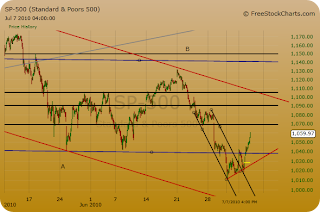Last week's
decline on the SSEC, got tongues wagging & China bears smacking their lips in excitement. This weekend i suggested that this was the final shake&bake, to throw
panicked retail feeders off the trail. And yes, i maintain my
medium-term bullish and
long-term bearish, outlooks. Just like it has in the recent past, Shanghai will probably lead again with the recovery. This long-term chart below, going back 13 years, speaks volumes:
Elliott Wave Theory
... is the primary reason i expect another wave up. After an impulsive decline from the 2007 highs, a corrective move up is expected, (most likely in the form of an A-B-C), followed by another impulsive decline. SSEC led the world recovery in Dec'08 with an impulsive wave A up(stopped by the 38.2%
fibonacci retrace), and has since gone sideways-then-downwards in wave B. Now we can expect a wave C up.
(Elliott Wave corrections can turn up in other variations, but this is the primary view for now)
Trendlines
... let's justify the name of the blog! From the chart above(click to enlarge), observe three different trendlines converging in the 2200-2300 area (
green circle):
- Bottom channel line
- Horizontal line from 2001 top
- Rising trendline connecting 2005 & 2008 bottoms
Hence, a high probability area for a turn. Now let's zoom in:
Observe the following
- Price is currently holding at the 61.8% retrace level, and a natural historical support level.
- Declining volume with the decline in price
- Clear positive divergence on the daily RSI
Socionomic Reasons
Introduced in an
earlier post,
socionomics is the study of social mood and its results in social actions. Here are some contrarian signals suggesting China may be reaching a short-term extreme in negative sentiment:
- Widely publicized labour strikes for wage increases.
- Bad fundamental(PMI) data, adding to negative news flows.
Suppport Levels & Targets
In the short-term, prices may take a while to stabilize, before a rebound. As long as they remain above
2200, the medium-term bullish view remains in force. The next serious support is the previous low of 1750.
Significant resistance level initially is
2700.
Minimum target for wave C medium-term would be the previous high of
3450. Further levels to the upside are
3900 &
4400. After that, an impulsive decline should follow, but that is a long way away.
If all the EW talk about impulses & corrections is confusing, feel free to browse this
free Elliott Wave Tutorial, or this basic
Elliott Wave Video.
Just my view folks, do your own homework & have a plan, before parting with your hard earned dough. All the best!







